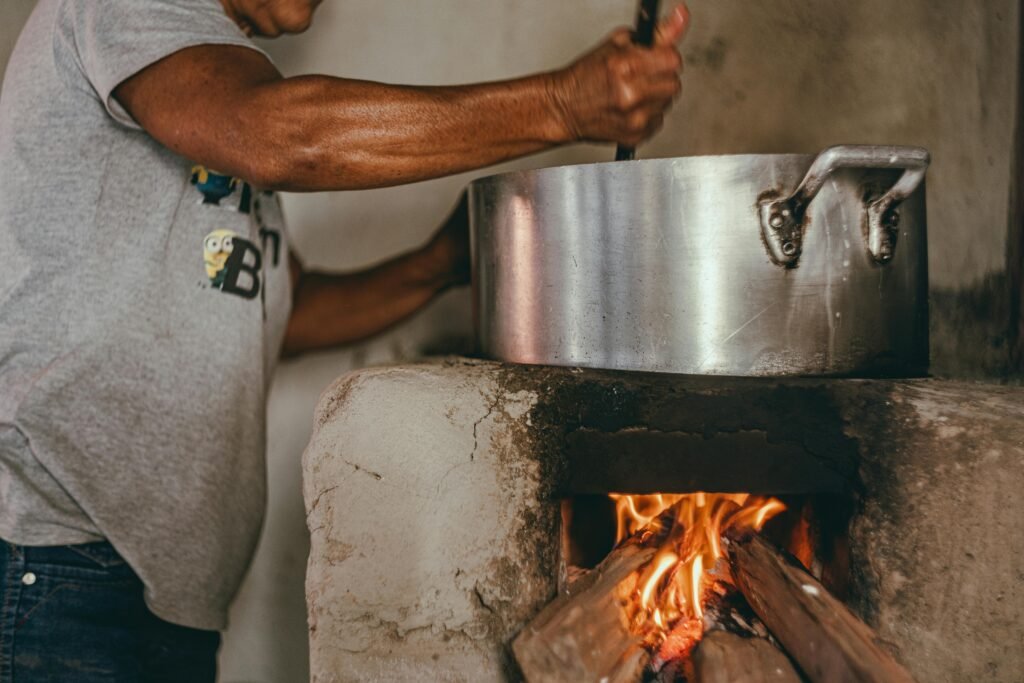Imagine cozy winter nights curled up by the fire, with its warm glow and crackling sounds bringing comfort and peace. But have you ever stopped to think about how efficient your fireplace is in terms of heat generation? In this article, we will explore some valuable tips on maximizing your fireplace’s eco efficiency, ensuring that you not only enjoy the comforting ambiance but also make the most out of the heat it provides. From selecting the right wood to properly maintaining your fireplace, discover expert advice that will help you create an eco-friendly and efficient source of warmth for your home.
Selecting the Right Fireplace
When it comes to selecting the right fireplace for your home, there are a few key factors to consider. One important aspect is the size and layout of your space. You want to choose a fireplace that is proportionate to the size of the room and complements the overall design aesthetic. Additionally, consider the placement of the fireplace in the room to ensure it provides maximum heat distribution.
Another aspect to consider is whether to choose a wood-burning or gas fireplace. Wood-burning fireplaces offer the traditional and cozy ambiance of a real fire, but they require regular maintenance and can produce more pollutants. On the other hand, gas fireplaces are convenient and easy to use, with adjustable flame settings and remote controls. They are also more energy-efficient and produce fewer emissions. Ultimately, the choice between the two will depend on your personal preferences and priorities.
Lastly, selecting an energy-efficient model is crucial for minimizing heat loss and reducing energy consumption. Look for fireplaces that have high efficiency ratings, such as those with Energy Star certification. These models are designed to burn fuel more efficiently, resulting in less waste and greater heat output.
Proper Fireplace Installation
To ensure your fireplace operates safely and efficiently, proper installation is essential. This includes considerations such as venting and airflow. Adequate venting is crucial to remove smoke, gases, and other byproducts of combustion from your home. Consult a professional to determine the best venting options for your specific fireplace and ensure proper installation.
Hiring a professional for installation is strongly recommended to avoid potential hazards and ensure compliance with local building codes. They have the expertise and knowledge to install your fireplace correctly, ensuring it functions properly and safely.
In addition to proper installation, insulating and sealing your fireplace helps prevent heat loss and improves efficiency. Insulating around the fireplace opening and installing airtight doors or screens can minimize drafts and keep the heat inside your home.

This image is property of images.pexels.com.
Using the Right Fuel
The choice of fuel for your fireplace can have a significant impact on its eco-efficiency. When selecting firewood, opt for sustainable sources that have been locally sourced. This helps reduce transportation emissions and supports local businesses. Additionally, choosing hardwoods such as oak, maple, or birch can provide a longer burn time and greater heat output.
Properly seasoning the wood is crucial for efficient burning. Seasoning involves drying the wood for at least six months to reduce its moisture content. Dry wood burns more efficiently and produces less smoke and pollutants.
Avoid using treated or painted wood in your fireplace as they can release harmful chemicals when burned. Stick to natural, untreated wood for a more eco-friendly burning experience. For those looking for alternative fuel options, consider using manufactured logs made from compressed sawdust, which burn cleaner and produce less ash.
Fireplace Maintenance
Regular chimney cleaning is vital to keep your fireplace functioning properly and prevent potential hazards. Over time, creosote and soot can accumulate inside the chimney, increasing the risk of chimney fires. Hire a professional chimney sweep to inspect and clean your chimney at least once a year.
Inspecting and repairing any damages to your fireplace is equally important. Cracks in the masonry or damaged flue liners can impact the efficiency and safety of your fireplace. Regular inspections can help identify and address any issues before they worsen.
Using fireplace accessories such as grates, screens, and dampers can contribute to more efficient burning. A grate elevates the firewood, allowing air to circulate underneath for better combustion. Screens can prevent sparks from flying out and protect against accidental burns. Dampers help control the airflow and can be adjusted to optimize burning efficiency.
Replacing worn-out components, such as gaskets or baffles, is also essential for maintaining the efficiency of your fireplace. These components can deteriorate over time, compromising the seal and contributing to heat loss.

This image is property of images.pexels.com.
Effective Fire Building Techniques
When it comes to building a fire, employing the right techniques can enhance its efficiency. Start by building a small, hot fire using dry kindling and small pieces of firewood. This allows the fire to establish a strong base and generate more heat.
Arrange the wood in a way that allows for proper airflow. Stack the wood with enough space between each piece to allow the flames and air to circulate. Avoid overcrowding the fireplace, as it can restrict airflow and hinder efficient burning.
Consider using the top-down burn method, where larger logs are placed at the bottom of the stack and smaller pieces above. This arrangement promotes more complete combustion by allowing the flames to reach the larger pieces first.
To maximize efficiency, avoid excessive unburned materials in the fireplace. Regularly remove ash and debris to maintain proper airflow and prevent blockages. An excessive buildup of ash can hinder combustion and reduce heat output.
Managing Airflow
Properly managing airflow is essential for maintaining an efficient and safe fireplace. Using fireplace dampers effectively helps control the amount of air entering the fireplace. Close the damper when the fireplace is not in use to prevent warm air from escaping. Additionally, opening the damper fully when lighting the fire helps establish a good draft and aids in the initial ignition.
For greater control over draft, consider installing adjustable vents or dampers. These allow you to fine-tune the airflow to optimize burning efficiency and heat output. Adjusting the vents based on the burn rate and desired heat level can help prevent excessive heat loss and minimize energy waste.
It’s important to note that leaving the damper open when the fireplace is not in use can allow drafts of cold air to enter your home, making it less energy-efficient. Make sure to close the damper tightly after each use to prevent heat loss.

This image is property of images.pexels.com.
Installing a Fireplace Insert
If you already have an existing fireplace, installing a fireplace insert can greatly enhance its efficiency and heating capabilities. When choosing an insert, consider factors such as the type of fuel it uses, heat output, and its compatibility with your existing fireplace.
Proper installation is crucial for maximum efficiency. Ensure that the insert is properly fitted into the existing fireplace opening and that the connections are secure. Hiring a professional for installation is highly recommended to ensure proper fit and proper venting.
To further improve heat distribution and circulation, consider using an efficient heat circulation system in conjunction with the fireplace insert. These systems can help transfer heat from the fireplace to other areas of your home, maximizing the benefits of your fireplace’s heat output.
Using Supplementary Heating Methods
To further optimize the eco-efficiency of your fireplace, consider utilizing supplementary heating methods. One option is to use a fireplace blower or fan. These devices help distribute the heat more evenly throughout the room, reducing the reliance on other heating sources.
Installing heat-resistant glass doors or screens can also contribute to better heat retention. By enclosing the fireplace when it is not in use, you can prevent warm air from escaping up the chimney and cold air from entering the room.
Using thermostatic controls or manual dampers provides another way to control the amount of heat generated by the fireplace. These mechanisms allow you to adjust the heat output to match your desired comfort level.
Insulating Your Home
To maximize the energy efficiency of your fireplace, it’s important to address insulation throughout your home. Pay special attention to the area around the fireplace. Insulate the wall behind the fireplace and the surrounding areas to minimize heat loss and prevent drafts.
Adding weatherstripping around doors and windows can also help prevent heat loss and improve overall insulation. Cracks and gaps around these areas can let cold air in and warm air out, making your fireplace less effective at heating your home.
If you have a chimney but do not use your fireplace regularly, consider insulating the chimney when it is not in use. This can prevent drafts and heat loss, saving energy and improving the efficiency of your home.
Utilizing Smart Home Technology
In the era of smart homes, integrating your fireplace with smart technology can provide additional convenience and control. Installing a smart thermostat allows for better temperature regulation and scheduling. You can set your fireplace to automatically turn on or adjust the heat output based on your preferred temperature settings.
Using smartphone apps to remotely control your fireplace offers another layer of convenience. With the touch of a button, you can turn your fireplace on or off, adjust flame settings, and monitor energy consumption. This allows you to control your fireplace from anywhere within your home or even when you’re away.
Integrating your fireplace with a home automation system offers even greater control and customization. You can synchronize your fireplace with other smart devices and create personalized settings tailored to your preferences.
By following these tips and implementing the recommended practices, you can maximize the eco-efficiency of your fireplace. Not only will you enjoy a warm and cozy atmosphere, but you will also reduce energy waste and contribute to a more sustainable future.




